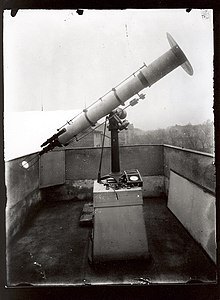Mathematical-Precision Mechanical Institute

In the first half of the 19th century, the Mathematical-Precision Mechanical Institute in Munich was the most important manufacturer of precise optics and measuring instruments in Europe. It later traded as the Munich Optical Institute . The legal successor G. & S. Merz GmbH existed until 1932.
history
It was founded in 1804 as an optical-mechanical workshop by three very innovative and powerful people: the inventor and later academician Georg Friedrich von Reichenbach (1771–1826), the professor and skilled precision mechanic Joseph Liebherr (1767–1840) and the entrepreneur Josef von Utzschneider . When Liebherr left the institute in 1812, the young optician Josef Fraunhofer took up his position and, with his world's best telescope lenses, helped bring the company to the top position in theodolites and astronomical telescopes .
The Mathematical-Precision Mechanical Institute obtained its high-quality crown and flint glasses from the art glassworks founded by Utzschneider in Benediktbeuern . This had hired the young Fraunhofer in 1809 and enabled him to carry out his research there on the refractive index of various glasses and the spectrum of the sun . With the development of a Fraunhofer lens largely free of chromatic aberration and its delivery to important observatories , not only did the Glashütte gain international recognition, but also the main company.
After Fraunhofer's death in 1826, the optician Georg Merz became plant manager. In 1839 he bought the institute together with Joseph Mahler and, among other things, completed the Königsberg heliometer begun by Fraunhofer . In 1851 Merz was the only German exhibitor at the World Exhibition in Paris. The company was a leader in the manufacture of large telescopes until the 1870s, but increasingly focused on military optics and smaller astro-spectroscopes.
Paul Zschokke took over the company from Jakob Merz in 1903. The G. & S. Merz GmbH was until death Zschokke in 1,932th
Technical services of the institute
In the more than 130 years of its existence, the company has built numerous refractors, microscopes, handheld telescopes, micrometers, spectroscopes and consumer optics (glasses, magnifying glasses, etc.).
Color-pure lenses for "giant telescopes"
Color-pure lenses were developed by John Dollond as early as 1750 , but in the first few decades they were limited to apertures of 10 to 15 cm. When using faster lenses, the astronomers had to accept stronger color fringes.
The institute achieved a breakthrough with Fraunhofer development of a 245 mm lens that left an air gap between the two lenses of the doublet instead of the usual cement . As a result, the light-collecting area could be more than doubled in one fell swoop, without any loss of image quality.
The first large telescope with this lens and a newly designed mount was delivered by the institute to the Dorpat observatory in 1824 (Russian Дерпт, today Tartu in Estonia) and made the then Russian State Observatory under Friedrich Wilhelm Struve the leading research facility, especially in the brand new double star research . Orders from other observatories were soon received and the workshop was expanded accordingly. An example of the same construction as the Dorpater refractor was given to the Berlin observatory in 1829 - after Fraunhofer's early death . With him, Johann Gottfried Galle discovered the planet Neptune in 1846 .
Heliometer
The development of the heliometer , which began under Fraunhofer, was also remarkable . The most precise instrument of its kind, which can measure the smallest angular differences with the double image technology , went to the Königsberg observatory . With it, Friedrich Wilhelm Bessel was able to measure the first fixed star parallax in 1837/38 and prove the long suspected star distances that were extremely large for previous ideas. The parallax of the " fast runner " 61 Cygni of 0.3 "(0.00008 °) resulted in 10 light years (instead of 11 today).
swell
- ↑ Note 160 mm aperture , 1790 mm focal length
- ↑ Alois Schmid, Katharina Weigand (ed.): Bavaria in the middle of Europe: from the early Middle Ages to the 20th century. CHBeck, 2005, ISBN 3406528988 , p. 268 ( limited preview in the Google book search).
- ↑ Culture and Technology 3/1988, p. 184 PDF file, p. 1.
- ↑ On the 225th birthday: The "immortal Fraunhofer"
- ↑ S. Merz: Brief overview of Georg Merz's life. Astronomische Nachrichten, Vol. 70 (1868), p. 361.
